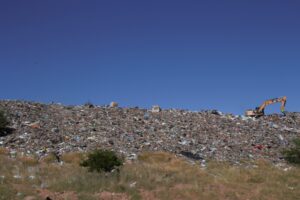Windhoek, Namibia, is one of the cleanest cities in Africa, second to Kigali, and is set to regain its number-one status. Since 2009, the citizens have started sorting out plastic bottles, cartons, paper and glass, which go for recycling. Now, the city of Windhoek, together with Smart City Sweden, is investigating how waste that is not recycled can be used for energy.
Like many other cities around the world, Windhoek is following the waste hierarchy, where waste that cannot be prevented should be recycled. But not everything can be recycled, and instead of putting it in the already restrained landfill, the waste can be used for energy in the form of electricity and heating or cooling. Landfills let out methane gas, around 25 times more potent than carbon dioxide. Other than that, heavy metals and other toxins could leak out into the water streams and contaminate the groundwater.
That was the focus when two representatives from Smart City Sweden visited Windhoek in March. The pre-feasibility is a collaboration together with the City of Windhoek and will look at the possibilities for a waste-to-energy plant in Windhoek. The plant would be one of the first in the southern part of Africa, making Windhoek, and Namibia, a frontrunner in the field.

The Kupferberg landfill
– The Kupferberg landfill in Windhoek is running out of capacity, and even though we are implementing recycling initiatives, it is not possible to recycle all the waste. Waste-to-energy is a part of the city’s Integrated Solid Waste Management Plan, as a complement to the city’s recycling initiatives. The energy recovered will also help us to enhance our sustainable energy generation and contribute to local energy generation for security reasons and affordability, says Michael Kavalata, Senior Engineer at the Department of Electricity, City of Windhoek.
Sweden has long experience using waste to generate energy and today, about 40 plants are providing Swedish households and industries with energy from waste. Waste incineration, combined with efforts to increase reuse and recycling, has led to only 0.1 % of the generated waste in Sweden going to landfills. Thanks to new incineration technology, the pollution of heavy metals from burning waste has decreased by 99 % in Sweden since 1985.
– Installing the right emission control system in such plants is critical to avoid air and water contamination. In Sweden and in the European Union, there are strict regulations on emission limits and environmental inspections. This has been a key point of discussion with Namibian authorities, to introduce stringent emission regulations, says Aditi Bhasin, Project Manager at IVL Swedish Environmental Research Institute.
The pre-feasibility study is co-financed by Smart City Sweden and the City of Windhoek and conducted together with experts from IVL Swedish Environmental Research Institute. The first stage of the project is expected to finish in June.
For more information about the study, contact Aditi Bhasin: [email protected].